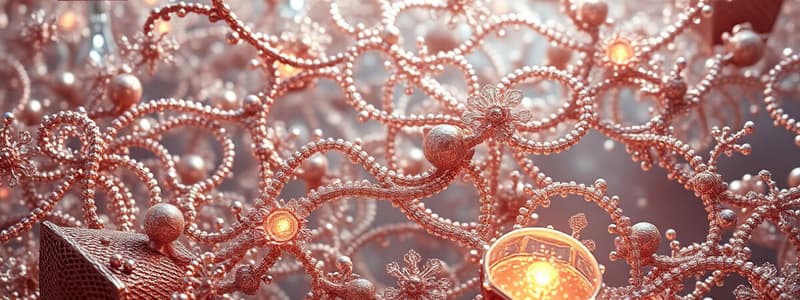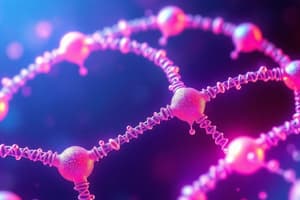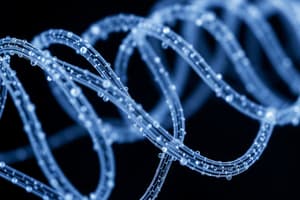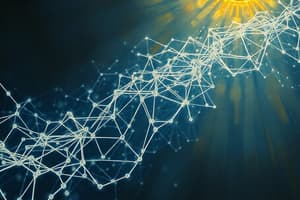Podcast
Questions and Answers
What is the core of a nanowire primarily made of?
What is the core of a nanowire primarily made of?
- Functionalized chemicals
- A secondary material
- The primary material (correct)
- A conductive polymer
Which synthesis method does NOT control the structure of nanowires?
Which synthesis method does NOT control the structure of nanowires?
- Molecular beam epitaxy (MBE)
- E-beam lithography (EBL) (correct)
- Vapor-liquid-solid (VLS) growth
- Chemical vapor deposition (CVD)
What does the shell of a nanowire typically consist of?
What does the shell of a nanowire typically consist of?
- The primary material
- Another coating material (correct)
- Electron beam resist
- Conductive polymers only
Which of the following is NOT a shape or morphology of nanowires?
Which of the following is NOT a shape or morphology of nanowires?
Which of the following materials can be used for the core of a nanowire?
Which of the following materials can be used for the core of a nanowire?
Which characteristic of E-beam lithography enhances its resolution?
Which characteristic of E-beam lithography enhances its resolution?
What is a common application of E-beam lithography?
What is a common application of E-beam lithography?
How small can the resolutions achieved by E-beam lithography be?
How small can the resolutions achieved by E-beam lithography be?
Study Notes
Nanowire Structure
- Nanowires are characterized by their core, shell, surface, and interfaces.
- Cores can be made of metals, semiconductors, insulators, and conducting polymers.
- Shells and surfaces can be functionalized with various materials.
- Nanowires can have diverse morphologies, including straight, bent, branched, core-shell, and hollow structures.
Nanowire Synthesis
- Different synthesis methods offer control over nanowire structure.
- Common methods include vapor-liquid-solid (VLS) growth, solution-liquid-solid (SLS) growth, chemical vapor deposition (CVD), molecular beam epitaxy (MBE), and electrochemical deposition.
E-beam Lithography (EBL)
- A high-resolution patterning technique for microelectronics and nanotechnology.
- Uses a focused electron beam to expose a resist material.
- The resist material undergoes a chemical change upon exposure to the electron beam.
- The scanned electron beam creates a pattern in the resist material.
- EBL enables resolutions down to 10 nm or smaller.
- A mask is not needed because the pattern is directly written onto the substrate.
EBL Applications
- Fabrication of integrated circuits, transistors, and other semiconductor devices in microelectronics.
- Creation of nanostructures, such as nanowires, nanotubes, and nanoparticles in nanotechnology.
Studying That Suits You
Use AI to generate personalized quizzes and flashcards to suit your learning preferences.
Related Documents
Description
Test your knowledge on nanowire structures and synthesis methods in nanotechnology. This quiz covers the characteristics of nanowires, various synthesis techniques, and the application of E-beam lithography. Perfect for students and enthusiasts in the material science field.



